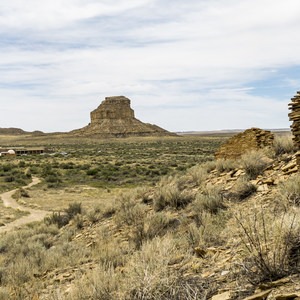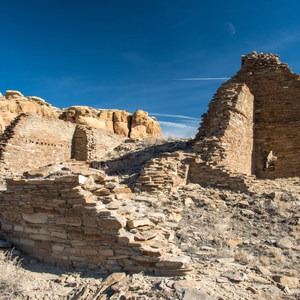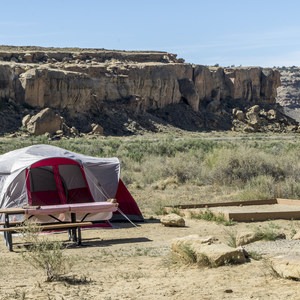You are here
From about 800 to the early 1100s, the Puebloan people of the four corners area built dozens of large stone dwelling and ceremonial buildings. During much of this time, Chaco Canyon was the cultural center of this world. Great roads extended for hundreds of miles, and trade prospered with people as far away as Central America and the Pacific coast. Today, Chaco Canyon is considered the premier archaelogical site in North America for exposing this era of human civilization. A visit to Chaco Canyon is not easy, but the rewards are enormous.
Any visit to the park should begin with the visitor center, which is conveniently located near the entrance to the canyon. Here the brief film and growing exhibits enhance the understanding of the role that Chaco Canyon played for the various people of the southwest. As of this writing, many of the recently rebuilt exhibit spaces have not yet been populated with the artifacts they will eventually have, but they should be soon. Just behind the visitor center is the short hike to the ruins at Una Vida.
The 9-mile one-way road that starts at the visitor center is the foundation for any visit. There are several ruins along this road that require little hiking and that provide a great introduction to the culture and the park:
- Hungo Pavi
- Chetro Ketl
- Pueblo Bonito
- Una Vida Ruins
- Pueblo del Arroyo
- Casa Rinconada
Accessible via trailheads on the loop road are other sites that require a bit more effort to reach (all distances are round trip). Trail permits are required for these backcountry hikes and available at the trailheads:
- Kin Kletso: A 0.6-mile short, flat hike to a small ruin.
- Pueblo Alto and New Alto: A 3.9-mile hike with gorgeous views
- Casa Chiquita: 2.0 miles
- Penasco Blanco: 7.4-mile trail with several petroglyph sites along the way.
- Tsin Kletsin: 3.6-mile loop trail
It is believed that the Chaco Canyon sites were primarily for ceremonial purposes and that only a small number of people lived here year-round, perhaps only about 50. Many different clans, cultures and languages were represented by the people in the Chaco Culture area of influence, and many people of the pueblos today trace their history back to the area and consider Chaco Canyon a sacred space to this day. This is truly an archaelogical wonderland and an awe-inspiring place to explore.
Chaco Canyon is challenging to visit. The best way to approach it is from the north, and Farmington makes the best base for an early morning departure. The last 14 miles of the journey are on dirt roads, and the last 7 miles can be quite rough, though they don't require four-wheel drive if the conditions are dry. Roads can become impassible after a rain. There is a small campground near the entrance that can take RVs up to 35 feet, but it is advisable to have reservations before making the drive out.
Logistics + Planning
Current Weather: Powered by Dark Sky




























Comments
Sign In and share them.